


NAME THAT TUNE




| ||
Front Game Rules (1974-81 version) | ||
| Two players compete. The game consisted of three separate rounds, each worth a specific amount of points. The first round was called "Melody Roulette". In this game, the host would spin two concentric wheels to determine a dollar value for the song played. The inner wheel had dollar amounts from $100-$500, while the outer wheel possibly doubled or even added a car to the first spin. The first player to name three tunes won the game, kept the money, and picked up 10 points. | 
| |
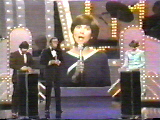
| The second round was called "Sing a Tune". Accompanied by the show's band, the show's featured vocalist (the most notable of whom was Kathie Lee Johnson, later to become Kathie Lee Gifford) would sing the lyrics to the song, "Laa-laa"-ing out any incriminating words. In the meantime, the players wrote down what they believed was the title to each song. Five tunes were sung; the one who had the most correct answers won a prize package and scored 10 points. | |
| The third round was the famous "Bid-a-Note". The host would read the contestants a clue to a tune, and the players bid back and forth to see who would try to name the tune in the fewest notes. The bidding continued until one player bid one note or one forced the other to "Name That Tune". If a player could not name the song, the other player got credit for it. The first player to get three tunes won the round, another prize package, and 20 points. At that point, the player with the highest score won the match. In the event of a tie, a sudden death tune was played. | 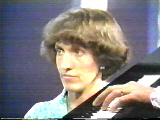
| |
Front Game Rules (1984-5 version) | ||

| In the '80s version of the show, the "Sing a Tune" round was replaced with "Tune Topics". In this game, five topics were shown, each an enigmatic clue to the theme of the tunes therein (For instance, "True Colors" might have songs with colors in the titles, with such hits as "Tie a Yellow Ribbon".) Five tunes were played; the contestant with the most right answers won a prize package and 10 points. | |
Front Game Rules (2001 version) | ||
| In 2001, Name That Tune underwent a transformation to accomodate music videos. Three players compete at the beginning. On the board would be three possible categories. Among the possibilities are: "Say It Again", where the players must decipher a line from a music video out of three choices; "Finish the Phrase", where the video would freeze in the middle and the contestant would have to buzz in and sing the next line; and "Spoken Word", where the players would be given the lyrics without music and they would have to identify the song. Right answers won 100 points; wrong answers deducted 100. The low scorer at the end of the round was eliminated. | 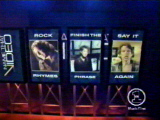
| |

| The second round was a new version of Bid-a-Note known as "Bid-a-Vid". Seven categories would be shown, each hinting at the artist. The leader from the previous round picked a category and got a clue for the song. (For example: "Jason Sehorn, Perhaps?/Popcorn Advertisement" could be "Subliminal" by They Might Be Giants). The players bid on how many seconds of the video they could see, with a maximum starting bid of 7 seconds. A right answer won a point, a wrong answer gave that point to his/her opponent. First to 3 points won the round, but a player had to earn the third point by naming a video and not by default. (If the other player goofed, s/he would get 7 seconds to see the video). | |
End Game Rules (1974-85 versions) - "Golden Medley" | ||
| The winner now had to name seven tunes in 30 seconds. With each right answer, the player won $500 in prizes. The contestant could pass on a tune if desired, but if s/he buzzed in with a wrong answer, the round was over.
Correctly identifying seven tunes in the '74-81 version won the right to return the following episode to name one more tune for a grand prize of $100,000 ($10K a year for 10 years). In the '84-5 version, getting seven tunes right qualified that player for a tournament, the winner of which would win $100,000 ($90K in prizes and $10K in cash). | 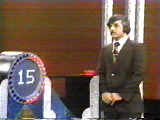
| |
End Game Rules (2001 version) | ||
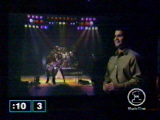
| The day's winner now had 60 seconds to identify 10 music videos. The player had to name the artist and song for each video. The player could pass as needed, and wrong answers were not penalized. Right answers won $500 each, getting all 10 videos won a new Toyota 4Runner and VH1's 100 Greatest Albums of Rock collection. | |
This is another one of those classic formats that everyone recognizes, although it might be a little more classic than the game truly deserves. The Bid-a-Note is among the most involving games in the genre, as the tension builds with each bid. And the $100,000 Tune, along with all of the hullaballoo that surrounded it, was a nice touch. Unfortunately, though, Jim Lange's tendency to overexplain things cost the show some style points in the 1984 run, as did a few of their directorial choices (such as zooming in on the Melody Roulette wheel three times a spin).
When the show returned in 2001, I was a bit skeptical as to how well the game could be pulled off in the era of music videos. That skepticism was put to rest, though, when the game made enough necessary changes, while holding true to the original concept. Karyn Bryant holds her own as the host, and the Bid-a-Vid round is just as involving as Bid-a-Note of years past. Overall, a very nice package.
Gameplay: 2 pts.
Host: 3 pts.
Presentation: 2 pts.
Execution: 1 pt.
Total Score: 8 pts.
Gameplay: 2 pts.
Host: 2 pts.
Presentation: 2 pts.
Execution: 1 pts.
Total Score: 7 pts.
Gameplay: 3 pts.
Host: 2 pts.
Presentation: 1 pt.
Execution: 2 pts.
Total Score: 8 pts.